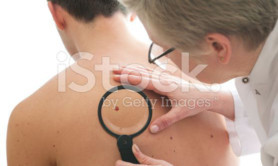
THOUSANDS of lives are set to be saved after scientists developed a test that diagnoses skin cancer in just 20 minutes with 100% accuracy.
The incredible technique uses a simple Doppler scan without the need for invasive biopsy tests, meaning patients can get a diagnosis while they wait.
It is hoped the revolutionary new kit could be installed in hospitals or even GPs’ surgeries in as little as two years’ time.
Last night Leigh Smith, of Melanoma Action and Support Scotland heralded it as the breakthrough everyone has been waiting for.
She said: “I think this is wonderful, excellent news.
“Dermatologists tell me only 3% of the lesions which turn up in their clinics are melanomas.
“For GPs melanomas can be very difficult to spot, it does take years of experience.
“A fast diagnosis would make a huge difference to treatment.
“If you knew it was melanoma you would be able to act quickly to take it off.
“It would save treatment time and the NHS millions of pounds.”
Scientists at Lancaster University have taken Doppler scanning technology, similar to that used to scan babies in the womb, and adapted it so it can scan moles.
The laser scans the mole and detects subtle differences in blood flow beneath the skin.
Incredibly, tests have proved 100% accurate in identifying patients who had melanomas.
The breakthrough comes as Scotland continues to see soaring levels of skin cancer, with a 273% increase in melanoma and non-melanoma cases since 1990.
Professor Aneta Stefanovska of Lancaster University, who led the research along with experts at Pisa University in Italy, said she hoped the technique will revolutionise the way skin cancer is diagnosed.
“I very much hope so,” she said.
“We offer a painless method by which a diagnosis can be made in about 20 minutes.
“The results of a biopsy are only available a few days after tissue has been invasively taken from the suspected area.”
Prof Stefanovska has been working on the project since 2007 and teamed up with Italian counterpart Professor Marco Rossi in 2010.
After developing their ‘melanometer’, with the help of student Gemma Lancaster, who has worked on the project as part of her PhD thesis, they tested it out on 55 patients with suspicious moles.
The machine successfully identified everyone who had melanomas which were later confirmed by traditional biopsies.
The team has now submitted a patent and is looking to secure financial backing to make the melanometer commercially available.
If it all comes together as they hope, the machine could be saving lives in just two years’ time.
Prof Stefanovska added: “Our ‘melanometer’ could be installed in every dermatology unit, or in every sophisticated GP’s surgery.
“I estimate its cost to be a couple of thousands of pounds at most.
“More importantly, it will save distress to those involved and their families, as it will minimise the time of uncertainty to almost nothing.
“Once the diagnosis is quicker, the treatment can be quicker, perhaps before metastases have developed, indeed saving lives.”
Tom Stansfeld, health information officer at Cancer Research UK, heralded the development.
He said: “This interesting research could, if replicated in much larger trials, offer a non-invasive way to help diagnose skin cancer.
“Spotting cancer early gives people the best chances of successful treatment and is key in helping us beat cancer sooner.”
The number of cases of skin cancer in Scotland is continuing to rise at a worrying rate.
Last year researchers looked at data on skin cancer and said it showed an increase of 273% in melanoma and non-melanoma cases since 1990.
Dr Gregory Parkins, one of the authors of the study presented at the World Congress on Cancers of the Skin in Edinburgh, said: “There are several factors that are likely to be contributing to this increase in skin cancer in Scotland, including more affordable holidays to sunny destinations, sunbed usage, and an ageing population.
“It will come as no surprise to the people of Scotland that a large proportion of us have pale skin, which makes the risk of developing skin cancer higher.
“This means education around skin cancer and sun protection is hugely important.”
Earlier this year fair skinned people from Scotland and the north of England were warned to enjoy the sun carefully.
According to Cancer Research UK people over 65 in Great Britain are around seven times more likely to develop malignant melanoma compared to 40 years ago.
The most recent figures show that on average around 5,700
pensioners are now diagnosed with melanoma each year compared with just 600 in the mid-1970s.
While age is one of the biggest risk factors for melanoma, the huge increase in pensioners being diagnosed with the disease is likely to be linked to the cheap package holiday boom dating from the 1960s and the desirability of having a tanned appearance even at the expense of painful sunburn.

Enjoy the convenience of having The Sunday Post delivered as a digital ePaper straight to your smartphone, tablet or computer.
Subscribe for only £5.49 a month and enjoy all the benefits of the printed paper as a digital replica.
Subscribe